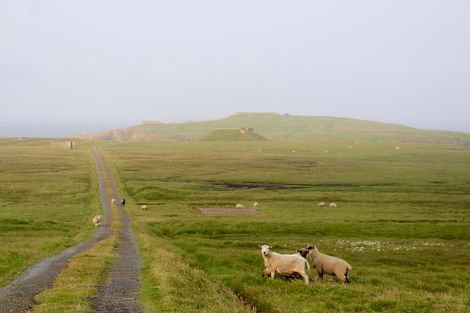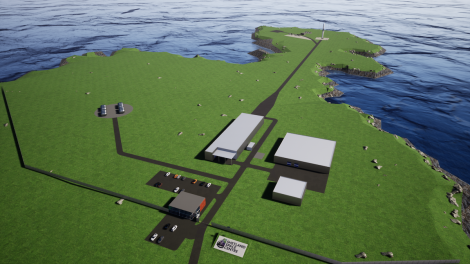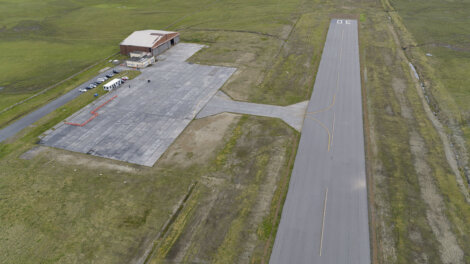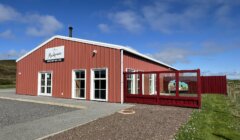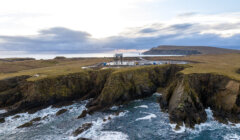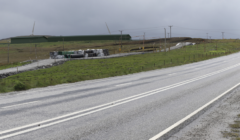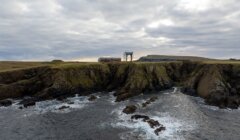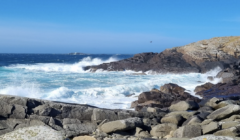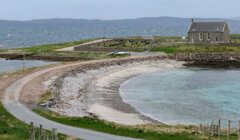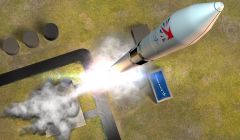Business / Space centre could result in bright future for Unst, team behind plans say
ROAD improvements costing £3 million could come to Unst if the Shetland Space Centre project goes ahead – while the team behind the plans say it would boost local employment and the island’s school roll as well as create a year-round draw for tourists.
The space centre team have also reassured local residents that there will be “no disruption to people in their homes” and that no one will be required to evacuate their houses as a result of space centre activity.
Those behind the plans have been taking part in virtual consultations this week ahead of a full planning application for a vertical launch spaceport and other infrastructure at Lamba Ness in the north of Unst.
Up to 30 rocket launches a year could take place during the day or night once operations are established, with each launch – which would shoot small satellites into the sky – taking around 20 seconds.
The public’s views will be fed into a report which will accompany the planning application, before an environmental impact assessment – which would cover aspects like natural heritage, noise, landscape and historic environment – is submitted.
There are also plans to create a launch and range control centre at the Saxa Vord Resort complex, and to use Baltasound Airport initially to store fuel and equipment storage.
A Q&A responding to local concerns has been published by the directors behind the project and it offers more details about what the impact on Unst could be.
Positive knock-on effects could be £3 million worth of improvements on the “dilapidated” road heading to Lamba Ness, which Shetland Space Centre expects to funds itself.
Become a member of Shetland News
It also believes there will be a job boost to Unst and the isles in general, with the space centre team wanting to employ locals first, then the rest of Shetland before offering them elsewhere.
Full-time jobs could be created in roles like site managers, technicians, security, wildlife wardens and admin support staff, although the team is unable to give an indication on the numbers of jobs which could be involved.
As a result there are hopes that the local school roll will increase, while there is also a belief that having a satellite launching facility could bring an “increase in tourist footfall for 10 months of the year”.
The team also hope that it could support better broadband provision, an enhanced ferry timetable and also give more justification to the possibility of a fixed link to Unst.
More details are also offered about the safety of rocket launches and the effect on the surrounding areas.
The team say that launches would take place in a northerly direction over the sea – “for safety reasons, rockets will not be permitted to fly over inhabited areas”.
“Rocket launches from Lamba Ness would avoid both oil fields to the west and east of Shetland,” the team added.
“They would also avoid the Faroe Islands to the north-west.
“That is not the case for alternative sites in Scotland. Also, transatlantic air traffic over Unst is meagre, which would mean little or no re-routing, unlike other sites.”
The height of rockets would be between 14m and 30m with a width of between 1m and 2m, and they would not have additional boosters on the side.
Parts of the rocket would fall into the sea “many kilometres to the north of Unst, in some cases up to 1,100km away”.
“It is possible to predict where they will come down and appropriate measures will be taken to eliminate danger,” the Q&A said.
“The UK Government is in talks with Norway, Faroe and Iceland on agreements to allow stages to fall in international waters. This is common practice within the space industry.”
Initial investigations say there is “no risk of an earthquake or subsidence being caused by any launch” at Lamba Ness, a site which was previously used by the RAF.
The space centre team also moved to assure local residents about the storage and transport of fuel in Unst.
It said almost all of the rockets planned for Unst will use a rocket propellant similar to aviation fuel, with regulations in place for its transport.
Liquid rocket fuel will be stored at Baltasound Airport, but the “amount of fuel will be markedly less than it was previously in Unst”.
At Lamba Ness, “some of the smaller red brick buildings may be demolished but the majority of the RAF Skaw buildings and all the bunkers on the site will remain”.
“There are plans to create a small interpretation centre with virtual imagery showing how RAF Skaw looked during the war years,” the Q&A added.
Shetland Space Centre said the site will be open to all walkers and visitors at “all times other than during notified launch days or launch rehearsals when it will be closed for a few hours only”.
In conclusion the team said it believed there would be “no adverse impact or change to the current way of life in Unst and certainly no change to the character”.
“Space is a very quiet industry and the workforce will be indoors working on the integration of the technology or working in offices,” it said.
“The Saxa Vord site will be completely refurbished within its current footprint and other than a refurbishment of the airfield and the new build integration sheds which are no bigger than a decent sized agricultural shed the visual impacts will be minimal.
“We have likened it to the RAF workforce returning but not in such numbers as before.”
Shetland Space Centre has also committed to setting up a community benefit fund supported by a “percentage of the profits” – similar to how large scale wind farms usually pay money into the local area based on its size.
It also intends to create an environmental watchdog body similar to the successful SOTEAG (Shetland Oil Terminal Environmental Advisory Group) group which was set up to oversee operations at Sullom Voe.
Shetland Space Centre intends to submit its full planning application to Shetland Islands Council in September.
It added that it has a “major commitment from an international aerospace company that is being supported by government to carry out the first vertical rocket launch from UK soil in 2021”.
However, Shetland Space Centre is “unable to go public about this because all government communications efforts are currently being devoted to Covid-19”.
It had previously been reported that aerospace giant Lockheed Martin was likely to shift its supported from a proposed spaceport in Sutherland in the Scottish Highlands – which has been awarded government funding in the aim of it becoming the UK’s first spaceport – to Unst.
Shetland Space Centre also recently said it was satisfied that a company which is said to have invested £2 million into the project was legitimate following doubts raised in the press.
Space centre chief executive Frank Strang said due diligence on Leonne International was carried out by the project’s major partners with “no issues” being raised.
North Isles councillor Ryan Thomson, who is originally from Unst, said there is “no doubt” that Unst is the “ideal location in the UK” for a space port.
“It’s good to see some of the concerns of residents addressed by the Shetland Space Centre in this comprehensive Q&A,” he said.
“Of course, a project of this size will always create questions as it progresses, and I’m happy to continue to raise any queries constituents may have with the company behind this exciting proposal.”
Become a member of Shetland News
Shetland News is asking its many readers to consider paying for membership to get additional features and services: -
- Remove non-local ads;
- Bookmark posts to read later;
- Exclusive curated weekly newsletter;
- Hide membership messages;
- Comments open for discussion.
If you appreciate what we do and feel strongly about impartial local journalism, then please become a member of Shetland News by either making a single payment, or setting up a monthly, quarterly or yearly subscription.






